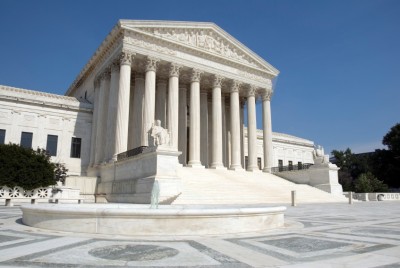Emmett Center Files Amicus Brief in U.S. Supreme Court GHG Case on Behalf of South Coast Air District
Legal Planet: Environmental Law and Policy 2014-01-28

UCLA’s Emmett Center filed an amicus curiae brief yesterday in Utility Air Regulatory Group (UARG) v. EPA, the U.S. Supreme Court case that will determine whether EPA’s greenhouse gas emissions rules under the Prevention of Significant Deterioration section of the Clean Air Act are valid. Arguing on behalf of the South Coast Air Quality Management District (the regulatory body overseeing the nation’s most polluted air basin) and itself, the Emmett Center brief takes issue with a central argument of opponents: that EPA’s rules will lead to “absurd results.” The brief demonstrates both that the current application of the PSD rules to large sources of greenhouse gases is working well and that EPA should be able to adopt rules and regulations that gradually bring into the regulatory ambit smaller sources of those gases without overwhelming the system and while staying true to the statutory language of the Clean Air Act .
In order to explain briefly the content of our brief, I’ve first excerpted my earlier post explaining what’s at issue in the case, which requires recounting the history of what led to the PSD rules:
The [Supreme] Court’s decision in Massachusetts v. EPA directed the Environmental Protection Agency to decide whether greenhouse gases are pollutants that must be regulated under the federal Clean Air Act. EPA then found that greenhouse gases endanger public health and welfare. The endangerment finding was upheld by the D.C. Circuit and the Supreme Court let stand that portion of the D.C. Circuit’s opinion.EPA’s next decision was to issue sthe “tailpipe rule.” The tailpipe rule establishes greenhouse gas emissions standards for automobiles under Section 202 of the Clean Air Act. The lower court [in Utility Air Regulatory Group] held that the Clean Air Act required the EPA to regulate greenhouse gas tailpipe emissions – the agency had no choice under the language of the statute. The tailpipe rules, too, remain untouched.The third and fourth rules are what will be at issue before the Supreme Court. Those rules are known as the “timing” and “tailoring” rules. These rules together work roughly as follows: under EPA’s view, the regulation of greenhouse gases for automobiles automatically triggers a different section of the Clean Air Act, what is known as the prevention of significant deterioration section (PSD). That section basically requires the EPA to regulate the emissions of any “major” source of a regulated pollutant. ”Major” is defined in the Clean Air Act to regulate any source that emits 100 tons per year of a regulated pollutant. The problem for the EPA is that the 100 tons per year amount would subject very, very small sources (a single home, perhaps, certainly apartment buildings and small businesses) to the permitting provisions of the Clean Air Act, something that those small sources have never had to comply with and that would be extremely expensive and administratively burdensome. So in the “tailoring” rule, the EPA only subjected large sources — new sources emitting 100,000 tons per year or more and existing sources making modifications that would increase emissions by 75,000 tons per year or more — to its greenhouse gas rules. Industry challenged both the application of the Clean Air Act to stationary sources and the tailoring rule as an impermissive interpretation of the Clean Air Act. The lower court found that the EPA is legally justified — indeed required — to regulate greenhouse gas emissions from stationary sources under the PSD provisions of the act. The Supreme Court will decide whether that ruling — that the PSD provisions must be used to regulate greenhouse gases — is correct.Industry groups in the URAG case argue that the threshold limits in the PSD provisions (100 tons per year) will lead to the absurd result of sweeping into EPA’s regulatory ambit “millions” of small sources, including potentially more than 4 million single family residences. As a result, opponents of the rules argue, the PSD provisions should not apply. The Emmett Center brief argues that EPA’s approach, in phasing in the regulation of sources in different stages, allows EPA to collect data on and then develop sensible rules for smaller sources that will be included in later phases. Importantly, new data already demonstrate that far fewer sources are likely to be included in the scope of the rule than initially estimated. And EPA has many tools in its arsenal that should allow the agency to streamline the application of the PSD rules to smaller sources. We argue that one of the most promising tools EPA can use is to apply a different measurement of emissions to small sources than is currently applied to large industrial sources. EPA currently uses “potential to emit” to measure the emissions of large industrial sources, meaning “the maximum capacity of a stationary source to emit a pollutant under its physical and operational design.” 40 C.F.R. § 51.165(a)(1)(iii). This measurement measures emissions as if an industrial facility were operating 24 hours a day, 365 days a year at maximum capacity. Such a measurement makes sense for industrial sources who might increase capacity as business grows and run 24 hours a day, for example, to increase industrial output. But our brief argues that using “potential to emit” for many small sources like a residence makes no sense: no family will run its air conditioner 24 hours a day, 365 days a year, including during winter months. Using a more accurate measure of average emissions shows that almost all residences emit drastically fewer greenhouse gases than they have the “potential” to emit and takes them comfortably under the statutory thresholds for regulation under the PSD provisions. Using tools such as a redefinition of potential to emit for small sources makes the application of the PSD provisions to small sources of greenhouse gases quite workable.Oral arguments in URGA v. EPA are scheduled for February 24th.